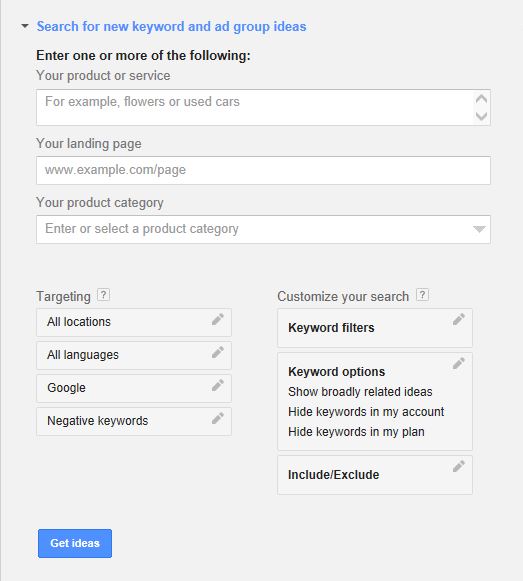SEO 101: Google Keyword Planner, A Content Marketer’s Secret Weapon
Search engine marketers are more than familiar with the Google Keyword Planner, one of the newer elements to Google AdWords. But if you’re a content marketer, you may not have investigated this tool – and that could be a huge mistake. Although Google no longer reveals which keywords direct traffic to your site from a search query, the Keyword Planner tool offers powerful insight into which keywords are popular and pertinent to your brand. These keywords can become launching points for your content, providing value to your audience – and traffic to your site.
Need help getting started? Here’s how to make the Google Keyword Planner your secret weapon:
STEP 1: SIGN UP FOR GOOGLE ADWORDS.
You can only access the Keyword Planner through an AdWords account. Once you’ve created yours, you can find the Keyword Planner tool under the “Tools and Analysis” tab in the navigation bar.
STEP 2: DISCOVER WHICH KEYWORDS YOU SHOULD IMPLEMENT IN YOUR CONTENT.
If your brand is using SEO to help boost your online visibility (and if you’re not, you should be), you should already have a list of terms and keywords people are using when searching for information about your industry, brand, and products or services. These should be the keywords you use in your content marketing strategy to complement your SEO efforts.
However, if you need more terms, or haven’t done any other keyword research, the Keyword Planner is here to help. Look for the “new keyword or ad group ideas” function. Then, type in your seed keyword; this is the most common word that is associated with your brand’s purpose. For example, a software company would use the keyword “security software” as their seed keyword. Additional filters on the tab, such as selecting your brand category, will help the tool return the most relevant results.

The “search for new keyword or ad group ideas” function also includes targeting capabilities to help you fine-tune your keyword search.
The Keyword Planner will generate a list of related keywords for you to sift through. Choose the terms most relevant to your brand to create content around. For example, the software company above might get a list of keywords that include “encryption”, “data protection” and “information security”. Encryption might make a good content topic – you could write a blog post on the most important elements to consider when buying encryption software, or the ten attributes you need to pay attention to when deploying a new encryption software system in an organization. Those post ideas provide value to customers that content generated from the broad“security software” keyword alone wouldn’t.

Use the Keyword Planner to establish a starting keyword and draw out an entire roadmap for your content.
STEP 3: EVALUATE WHICH KEYWORDS YOU SHOULD IMPLEMENT IN YOUR CONTENT.
While Google will no longer show you direct traffic results, you can see which keywords generate high levels of search traffic. In the Keyword Planner, go to the “get search volume” section, and either manually type in or upload a list of keywords you have identified as relevant to your brand. The Keyword Planner will then show you the average amount of monthly searches for that term, as well as an estimate of the level of competition that keyword receives.
STEP 4: DECIDE WHICH OPPORTUNITIES TO USE IN YOUR CONTENT STRATEGY.
The most ideal result is a keyword that has both a high number of searches and a low amount of competition, but these terms are few and far between. Most likely, you’ll have to make a decision based upon your goals; while a term with a low competition might be easier to get results for, that low competition usually means that there are less searches for the keyword. Conversely, a high competition keyword often has a much higher average number of searches than a low competition keyword, but your content will be vying against a large number of other content producers within those searches’ results pages. You’ll have to decide which method is best for your brand and the audience you are trying to reach.
The Keyword Planner Tool might have been originally designed to help SEM professionals optimize pay-per-click ads, but since most aspects of digital marketing perform best when integrated, using this tool to help inform your content marketing strategy means better results across your entire digital marketing strategy. Knowing which keywords are important to your brand – and are being searched for online – will help you create valuable, useful content for your audience, which is the main goal for any content marketing campaign.
While the Keyword Planner is the best free keyword research tool available, there are some other free alternatives: Wordpot offers a free keyword generator, although its index was last updated in 2011. SEO Book’s Keyword Tool is also free, and a little more robust; it generates suggested daily search volumes and price estimates from Google AdWords. No matter what tool you use, generating and incorporating keywords into your brand’s content marketing is crucial to distributing your content to relevant users.
Image Credit: Shutterstock.com. All images are used under license.
Screenshot taken at 03/18/2014 of www.adwords.google.com/ko/KeywordPlanner/Home
1 comments:
Ahrefs
While we’re on the topic of SEO, I wanted to mention Ahrefs. Ahrefs is a tool that allows you to do keyword research to ensure you’re targeting the best keywords with the highest traffic and lowest difficulty to rank for.
While this tool isn’t free or cheap, they do offer a free two-week trial. Alternatively, you can use their competitors like Moz or SEMrush (who also have free trials, hint hint). Whichever one you choose, if you’re serious about ranking on Google, I highly recommend a keyword research tool. Without them, you only have access to Google Keyword Planner, which doesn’t really help you find the right keywords.
Post a Comment